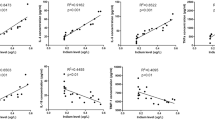Abstract
Purpose
The present review is aimed to introduce an new occupational lung disease, Indium Lung.
Methods
We searched case reports and epidemiological studies concerning indium-related lung diseases and reviewed.
Results
Up to March, 2010, 7 cases of interstitial pneumonia in Japanese indium-exposed workers, two cases of pulmonary alveolar proteinosis (PAP) in US indium-exposed workers, one case of PAP in a Chinese indium-exposed worker, and 4 cross-sectional surveys in Japan had been published. All cases and epidemiological studies in Japan indicate that exposure to hardly soluble indium compounds causes interstitial as well as emphysematous lung damages, which we call “Indium Lung”. Based on the epidemiological studies, the Japan Society for Occupational Health proposed 3 μg/l of indium in serum as an occupational exposure limit based on biological monitoring to prevent significant increase of KL-6.
Comments
Long-term follow-up of currently and formerly indium-exposed workers is essential not only to clarify the natural history of indium lung but also to trace the incidence of lung cancer. It is also necessary to elucidate the mechanism of indium lung and difference in clinical manifestations between Japanese and US cases.
Similar content being viewed by others
References
American Conference of Governmental Industrial Hygienists (ACGIH) (2001) Documentation of the threshold limit values and biological exposure indices, 7th edn. American Conference of Governmental Industrial Hygienists, Cincinnati
Chonan T, Taguchi O, Omae K (2007) Interstitial pulmonary disorders in indium-processing workers. Eur Respir J 29:317–324
Cummings KJ, Walter E, Donat WE, Ettensohn DB, Roggli VL, Ingram P, Kreiss K (2010) Pulmonary alveolar proteinosis in workers at an indium processing facility. Am J Respir Crit Care Med 181:458–464
Hamaguchi T, Omae K, Tanaka A, Hirata M, Takebayashi T, Kikuchi Y, Yoshioka N, Nishiwaki Y, Taguchi O, Chonan T (2008) Exposure to hardly soluble indium compounds in the ITO producing and recycling plants is a new potent risk of interstitial lung damage. Occup Environ Med 65:51–55
Homma T, Ueno T, Sekizawa K, Tanaka A, Hirata M (2003) Interstitial pneumonia developed in a worker dealing with particles containing indium-tin oxide. J Occup Health 45:137–139
Homma S, Miyamoto A, Sakamoto S, Kishi K, Motoi N, Yoshimura K (2005) Pulmonary fibrosis in an individual occupationally exposed to inhaled indium-tin oxide. Eur Respir J 25:200–204
Japan Society for Occupational Health (2007) Documentation of occupational exposure limit of indium and compounds based on biological monitoring. San Ei Shi 45:137–139 (in Japanese)
Minami H (2010) Trend of demand, supply and price of indium and gallium. Kinzoku-Shigen Report (May), 81–93. (in Japanese)
Nakano M, Kamata H, Saito F, Tanaka A, Hirata M, Ishizaka A, Omae K (2007) A case of indium lung disclosed in health checkup. Occup Health J 30:25–29 (in Japanese)
Nakano M, Omae K, Tanaka A, Hirata M, Kikuchi Y, Yoshioka N, Nishiwaki Y, Chonan T (2009) Causal relationship between indium compound inhalation and effects on the lungs. J Occup Health 51:513–521
National Toxicology Program (2001) Toxicology and carcinogenesis studies of indium phosphide (CAS No. 22398-90-7) in F344/N rats and B6C3F1 mice (inhalation studies). Natl Toxicol Program Tech Rep Ser 499:7–340
Nogami N, Shimoda T, Shoji S, Nishima S (2008) Pulmonary disorders in indium-processing workers. J Jpn Respir Soc 46:60–64 (in Japanese)
Ohnishi H, Yokoyama A, Kondo K, Hamada H, Abe M, Nishimura K, Hiwada K, Kohno N (2002) Comparative study of KL-6, surfactant protein-A, surfactant protein D, and monocyte chemoattractant protein-1 as serum markers for interstitial lung diseases. Am J Respir Crit Care Med 165:378–381
Taguchi O, Chonan T (2006) Three cases of indium lung. J Jpn Respir Soc 44:532–535 (in Japanese)
Takeuchi K (2008) Pulmonary toxicity of indium. Kokyuu 27(6):599–603 (in Japanese)
Tanaka A, Hirata M, Kiyohara Y, Nakano M, Omae K, Shiratani M, Koga K (2010) Review of pulmonary toxicity of indium compounds to animals and humans. Thin Solid Films 518:2934–2936
Uchida K, Nakata K, Trapnell BC, Terakawa T, Hamano E, Mikami A, Matsushita I, Seymour JF (2004) High-affinity autoantibodies specifically eliminate granulocyte-macrophage colony-stimulating factor activity in the lungs of patientswith idiopathic pulmonary alveolar proteinosis. Blood 103:1089–1098
U.S. DHEW (1964) Smoking and health: report of the Advisory Committee to the Surgeon General of the Public Health Service. Public Health Service Publication No. 1103. Washington, DC
Xiao YL, Cai HR, Wang YH, Meng FQ, Zhang DP (2010) Pulmonary alveolar proteinosis in an indium-processing worker. Chin Med J 123:1347–1350
Conflict of interest
None.
Author information
Authors and Affiliations
Corresponding author
Rights and permissions
About this article
Cite this article
Omae, K., Nakano, M., Tanaka, A. et al. Indium lung—case reports and epidemiology. Int Arch Occup Environ Health 84, 471–477 (2011). https://doi.org/10.1007/s00420-010-0575-6
Received:
Accepted:
Published:
Issue Date:
DOI: https://doi.org/10.1007/s00420-010-0575-6




